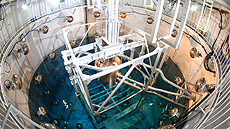XMASS continues dark matter debate
 |
XMASS is the latest of multiple experiments to contradict a previous dark matter discovery claim, but the conversation isn't over yet. Photo courtesy of Kamioka Observatory, ICRR, The University of Tokyo |
Since 1998, scientists on the DAMA-LIBRA experiment at Gran Sasso National Laboratory in Italy have claimed the discovery of an increasingly statistically significant sign of dark matter.
This week, the XMASS experiment in Japan joined the LUX, Xenon100 and CDMS experiments in reporting results that seem to contradict that claim.
Scientists look for dark matter in many ways. Both this result from the XMASS experiment and the results from DAMA-LIBRA look for something called annual modulation, a sign that the Earth is constantly moving through a halo of dark matter particles.
As the sun rotates around the center of the Milky Way, the Earth moves around the sun, completing one revolution per year. During the first half of the year, the Earth moves in the same direction as the sun; during the second half, the Earth completes its circle, moving in the opposite direction.
When the sun and Earth are moving in the same direction, the Earth should move through slightly more dark matter than when the sun and Earth are moving in opposite directions. So scientists should see a few more dark matter particles hit their detectors during that part of the year.
Experiments other than DAMA-LIBRA have seen hints of an annual modulation, but only the CoGeNT experiment has ever provided support for DAMA-LIBRA's claim that this modulation comes from dark matter.
The effect could be caused by other annual changes. Pressure and temperature could affect an experiment. Atmospheric changes with the seasons could affect the number of cosmic rays that reach the experiment. Background radiation from radon gas has been known to change seasonally for underground experiments because of its interaction with the water table in the rock, says Fermilab scientist Dan Bauer of the CDMS experiment.
"Nobody's been able to put their finger on what's causing the DAMA modulation," he says. "We can't find the smoking gun."
Read more
—Kathryn Jepsen
|